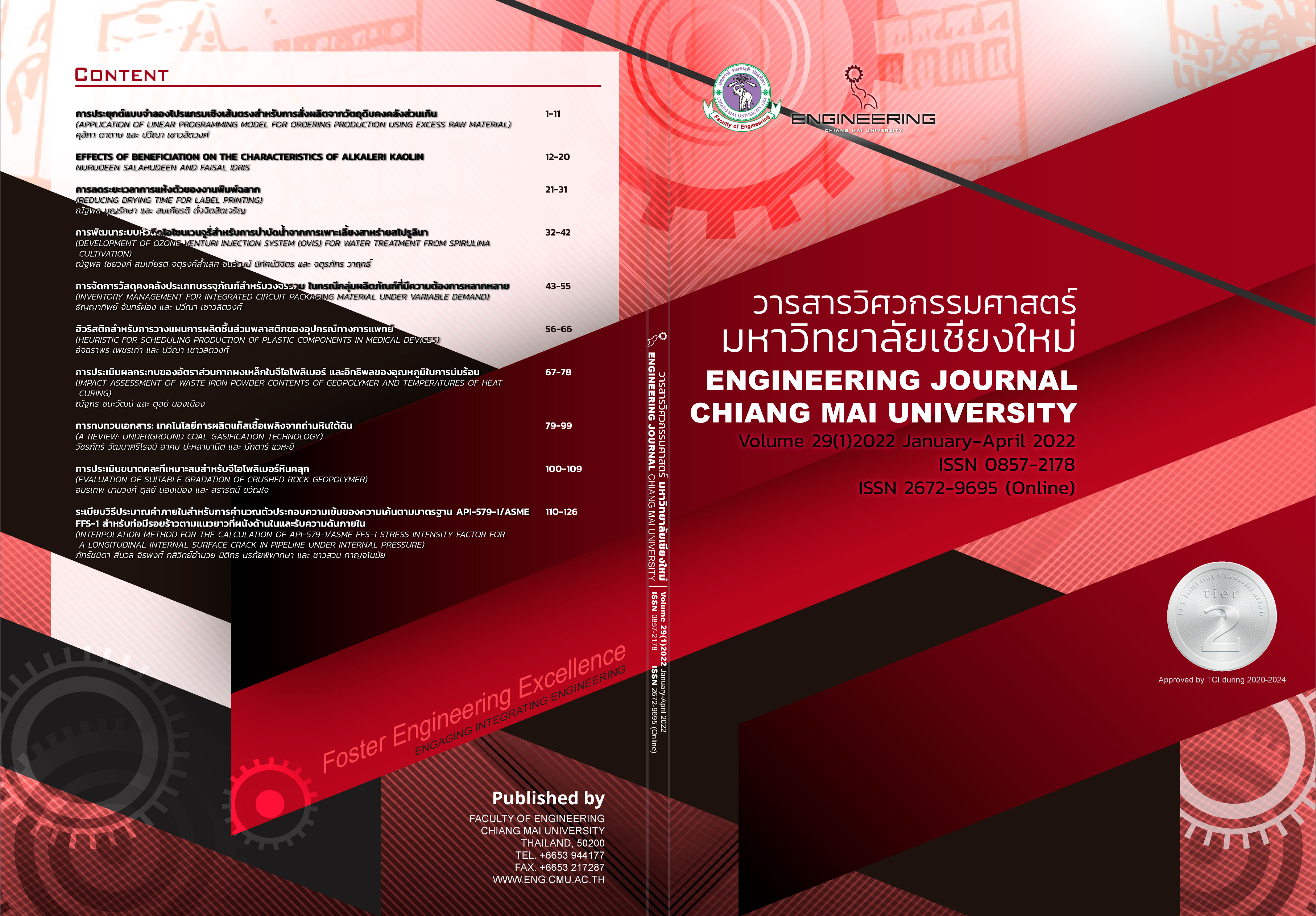Effects of Beneficiation on the Characteristics of Alkaleri Kaolin
คำสำคัญ:
Alkaleri clay, Kaolinite, XRD, SEM, pH, Specific gravityบทคัดย่อ
Effect of beneficiation on characteristics of a local clay Alkaleri village in Bauch State, Nigeria is presented. The raw clay was beneficiated by wet beneficiation method. Mineralogical characterization of the clay was carried out using X-ray diffraction (XRD) machine. Physicochemical characterization of the clay was carried out using X-ray fluorescence (XRF) machine, pH meter and specific gravity analyzer. Morphological characterization of the clay was conducted using scanning electron microscopic (SEM) machine. The qualitative XRD analysis showed presence of kaolinite peaks at Bragg’s angle values of 12.4⁰, 20.5⁰, 24.9⁰, 35.1⁰, 55.4⁰ and 62.3⁰ and presence of quartz peaks at Bragg’s angle values of 26.6⁰ and 38.5⁰. The XRD analysis further showed that the raw clay possessed 84% kaolinite and 16% quartz impurity. The XRF result of raw Alkaleri clay showed that the clay contained 53 wt% silica and 42.4 wt% alumina making the silica-alumina ratio of the 1.25. Other metallic oxides present in the clay as impurity were iron oxide, titanium oxide, magnesium oxide, potassium oxide, zirconium oxide, sulfur oxide and cesium oxide, present at 0.9, 2.2, 0.7, 04, 0.2, 0.1 and 0.1 wt%, respectively. The specific gravity values of the raw and beneficiated clay were 2.18 and 2.16, respectively. The average pH values of the raw and beneficiated were 4.9. and 6.0, respectively. The SEM results revealed that Alkaleri clay possessed dispersed lump-like morphology with tetrahedral or hexagonal imperfect crystal shapes and the average particle size of the clay was estimated to be 500 m.
เอกสารอ้างอิง
H. M. Baioumy, “Geochemistry and Origin of the Cretaceous Sedimentary Kaolin Deposits, Red Sea, Egypt,” Geochemistry, vol. 74, no. 2, Jun., pp. 195-203, 2014.
R. L. Donahue, R. W. Miller, and J. C. Shickluna, “Soils: an introduction to soils and plant growth,”
th edition. New Jersey: Prentice-Hall, 1983.
J. M. Huggett, “Clay minerals: reference module in earth systems and environmental sciences,” London: Elsevier, 2015.
T. A. Aragaw, F. T. Angerasa, “Synthesis and characterization of Ethiopian kaolin for the removal of basicyellow (BY 28) dye from aqueous solution as a potential adsorbent,” Heliyon, vol. 6, no. 9, Sep., 2020.
T. Zhang, T. Wang, K. Wang, C. Xu, and F. Ye, “Development and characterization of NaCl-KCl/Kaolin composites for thermal energy storage,” Solar Energy, vol. 227, pp. 468–476, 2021.
A. Aziz, A. Bellil, I. Hassani, M. Fekhaoui, M. Achab, A. Dahrouch, and A. Benzaouak, “Geopolymers based on natural perlite and kaolinic clay from Morocco: Synthesis, characterization, properties, and applications,” Ceramics International, vol. 47, no. 17, Sep., pp. 24683-24692, 2021.
J. S. Reed, “Introduction to the principles of ceramic processing,” John Wiley & Sons, 1988.
H. Yahaya, “Nigeria: over 3 billion tonnes of kaolin abandoned in states,” allafrica.com, Aug. 4, 2020, [Online]. Available: //allafrica.com/stories/202008040175.html. [Accessed Nov. 1, 2001].
G. P. Ojo, U. G. Igbokwe, C. J. Egbuachor, and K. K. Nwozor, “Geotechnical Properties and Geochemical Composition of Kaolin Deposits in Parts of Ifon, Southwestern Nigeria,” American Journal of Engineering Research, vol. 6, pp. 15-24, 2017.
N. Salahudeen, U. Mohammed, and M. N. Yahya, “Chemical, morphological characterizations of Ririwai biotite and determination of yield point of its weighting agent application in drilling mud,” Nigerian Journal of Technology, vol. 40, no. 2, pp. 269–274, Oct. 2021.
J. B. Mokwa, S. A. Lawal, M. S. Abolarin, and K. C. Bala, “Characterization and evaluation of selected kaolin clay deposits in Nigeria for furnace lining application,” Nigerian Journal of Technology, vol. 38, no. 4, Oct., pp. 936–946, 2019.
W. D. Keller and K. Matlack, “The pH of clay suspensions in the field and laboratory, and methods of measurement of their pH,” Applied Clay Science, vol. 5, no. 2, Aug., pp. 123–133, 1990.
A. Ababneh, F. Matalkah, and R. Aqel, “Synthesis of kaolin-based-activated cement: carbon footprint, cost and energy assessment,” Journal of Materials Research and Technology, vol.9, no. 4, pp. 8367-8378, 2020.
Y. W. Dou, F. L. Tu, Y. Wu, X. Wang, G. Lu, and L. Zhao, “Facile preparation of kaolin supported silver nanparticles mediated by Thymbra spicata extract and investigation of the anti-human lung cancer properties,” Journal of Saudi Chemical Society, vol. 25, no. 9, Sep., pp. 101303, 2021.
S. Shaaibu, A. U. Abdullahi, Y. O. Sadiq, and O. A. Odey, “Physio-Chemical and Thermal Properties of Alkaleri Kaolin, Bauchi State, Nigeria for Ceramics Applications,” FUTY Journal of the Environment,
vol. 14, no. 1, Nov., pp. 60-68, 2020.
R. Dewi, H. Agusnar, Z. Alfian, and Tamrin, “Characterization of technical kaolin using XRF, SEM, XRD, FTIR and its potentials as industrial raw materials,” Journal of Physics: Conference Series, vol. 1116,
no. 4, Dec., pp. 042010, 2018.
W. D. Keller and K. Matlack, “The pH of clay suspensions in the field and laboratory, and methods of measurement of their pH,” Applied Clay Science, vol. 5, no. 2, Aug., pp. 123-133, 1990.
ดาวน์โหลด
เผยแพร่แล้ว
ฉบับ
ประเภทบทความ
สัญญาอนุญาต
ลิขสิทธิ์ของบทความที่ตีพิมพ์ในวารสารฉบับนี้จะยังเป็นของผู้แต่งและยินยอมให้สิทธิ์เผยแพร่กับทางวารสาร
การเผยแพร่ในระบบวารสารแบบเปิดนี้ บทความจะสามารถนำไปใช้ได้ฟรีในการศึกษา และในทางที่ไม่เกี่ยวกับการค้า




